|
|
O C T O B E R 2 0 0 2 |
|
|
|||
The cosmic star formation history |
|
Scientists at the Max-Planck-Institute for Astrophysics and their collaborators have developed new techniques to simulate star formation and associated galactic winds. Using a set of very large numerical simulations of galaxy formation, they were able to derive detailed predictions for the history of star formation in the universe. |
|
The currently most successful theory for the formation of galaxies in the universe is based on the so-called LCDM model. One here assumes that the dominant mass component in the universe is formed by cold dark matter (CDM), which probably consists of elementary particles that have not been detected directly so far. Ordinary baryons, on the other hand, make up for only about 13% of all the mass. In addition, there appears to be a non-vanishing cosmological constant, as for example suggested by observations of distant supernovae. At the present day, this vacuum energy density actually dominates over the combined energy densities of dark matter and baryons. |
|
Over the last two decades, computer simulations of the gravitational growth of structure in the LCDM model have greatly helped to understand the formation process and the properties of galactic halos, as well as their distribution and motion in space. This part of the structure formation process is now comparably well understood. However, cosmological simulations that try to include star formation in order to allow a direct comparison with the luminous properties of observed galaxies have been met with substantially more difficulty, and are therefore theoretically still much more uncertain. |
|
One generic problem of these studies has been that the radiative cooling of gas appears to be too efficient, such that a substantial luminosity excess of the simulated galaxies compared to the real universe results. It is believed that this failure to account for the data is caused by an incorrect modelling of the physics of star formation and its associated feedback processes. In particular, it is believed that the overcooling problem might be resolved once feedback processes like supernova explosions or stellar winds are properly taken into account. Unfortunately, the physical nature of feedback is only very poorly understood, and there are also substantial numerical difficulties in trying to model them within simulations. |
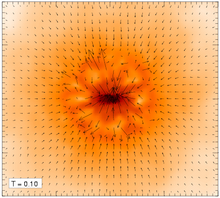 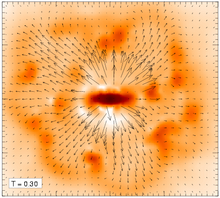 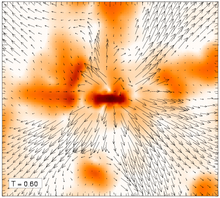
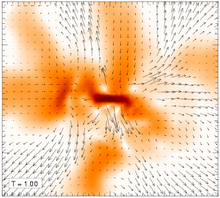 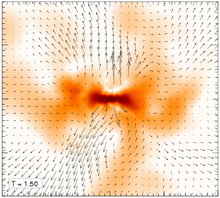 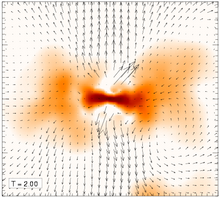
| |
|
|
However, in a recent study, Springel & Hernquist proposed a new simulation method to account for the regulation of star formation by supernovae in the dense interstellar medium (ISM). Using an analytic sub-resolution model for the physics of the ISM, their method successfully circumvents some of the main numerical problems ususally encountered in these studies. They also for the first time included a novel description for feedback by galactic winds. Figure 1 shows the velocity field of the gas in a forming disk galaxy when such a wind is included. In the small galaxy shown here, the wind can actually escape from the galaxy, transporting both gas and heavy elements that were synthesized in stars out of the galaxy. As a result, the amount of gas available in the galaxy for star formation becomes much smaller. However, despite this strong effect on the luminosity of the forming disk, its morphological properties are still broadly consistent with observed spiral galaxies, as seen in Figure 2. |
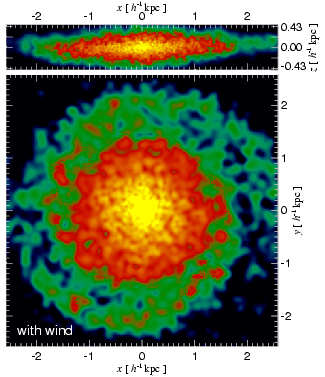 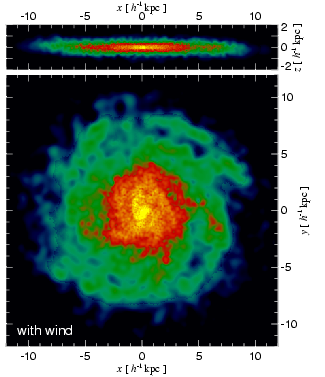
| |
|
|
Galactic winds have a particularly strong influence on the star formation rate of small galaxies, where winds are able to escape from the gravitational pull of their parent dark matter halos. However, in large systems, the winds are confined, such that they are not efficient in suppressing star formation. Feedback by winds hence primarily reduces the star formation activity in small galaxies, which is exactly what appears to be required to improve the agreement between observations and predictions of the LCDM model. This is one of the reasons why galactic winds receive a lot of attention in current theoretical studies. Another interesting effect of winds is that they transport metals into the intergalactic medium, thereby potentially explaining why heavy elements are observed in the low density gas that resides in intergalactic space, as probed by absorption line studies of quasar spectra. |
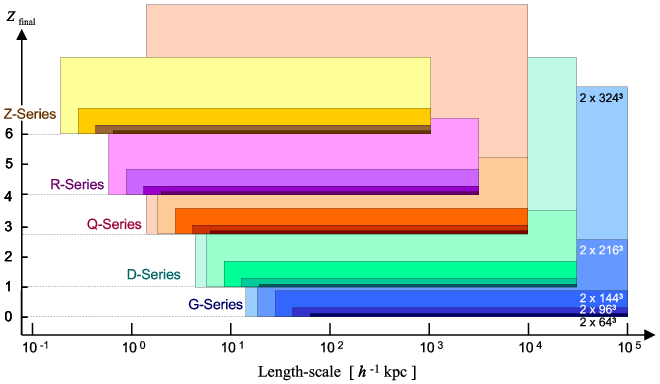 | |
|
|
Galaxy formation proceeds as a hierarchical process in the LCDM scenario. Small objects form first and then gradually grow by accretion and merger events to become more massive galaxies. Numerical predictions for the total star formation rate in the universe are particularly challenging in this model because a complete inventory of all star forming galaxies requires that simulations simultaneously resolve star formation in galaxies of all relevant mass scales. This implies a substantial demand for high dynamic range in these simulations. In addition, the feedback processes mediated by galactic winds are particularly important in galaxies of small mass, which further increases the difficulty of these computations, because these galaxies are typically close to the resolution limit, yet an accurate treatment of the winds is essential to correctly describe the suppression of star formation by feedback. In a single simulation, the required mass resolution can in fact not be achieved in volumes large enough to be representative for the universe at the present day. It is likely that even the advances in computer technology expected for the next few years will not change this situation much. However, using a special simulation strategy, Springel & Hernquist have been able to largely circumvent this problem. Figure 3 illustrates schematically the simulations we run on a Linux-Cluster at the Center for Parallel Astrophysical Computing at Harvard-CfA. By using a sequence of box sizes combined with a special analysis technique we were able to drastically extend the dynamic range over which the numerical model for galaxy formation could be probed, achieving a dynamic range of nearly 18 decades in mass. For each box size, we also carried out extensive resolution studies, allowing reliable tests for numerical convergence within each box size. |
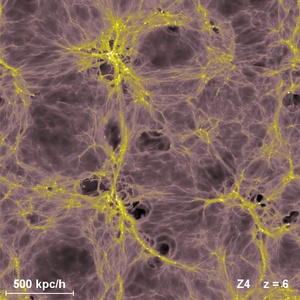 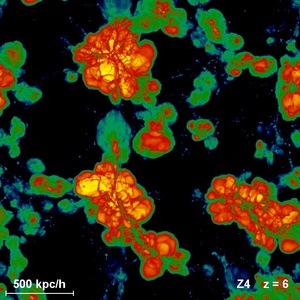 
| |
|
|
At high redshift, the first star forming galaxies begin to drive violent outflows into the intergalactic medium, as seen in Figure 4. When the galactic winds are stopped by shocks, they lead to the generation of bubbles in the IGM, which are filled with hot metal-enriched gas. Galactic winds may hence be of crucial importance to understand the observed metal enrichment of the low-density intergalactic gas. Focusing on the luminous properties of galaxies themselves, perhaps an even more crucial effect is the suppression of the overall star formation rate in small galaxies. Without winds, galaxies like the ones shown in Figure 5 would be substantially brighter due to the overcooling problem. |
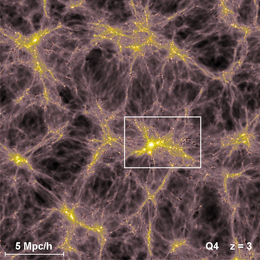 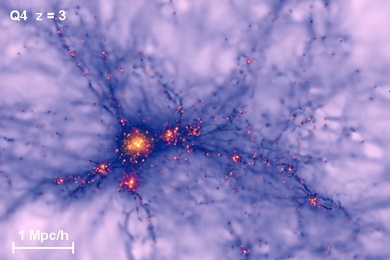
| |
|
|
In Figure 6, we show the history of cosmic star formation predicted by the composite simulation set, both as a function of redshift, and in a cumulative form as a function of time. The star formation density is predicted to peak already quite early in the history of the universe, at a redshift of about z=5.5. Note that about half of the stars are predicted to have been already in place 10 billion years ago. The total fraction of baryons that end up in long-lived stars is predicted to be only about 10%, which is consistent with observational data. Without the inclusion of galactic winds, this number would have been substantially higher, in conflict with many observational constraints. |
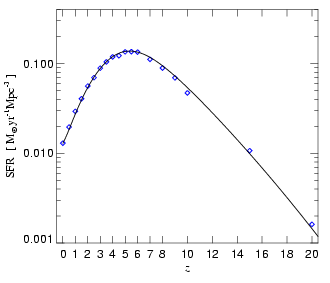 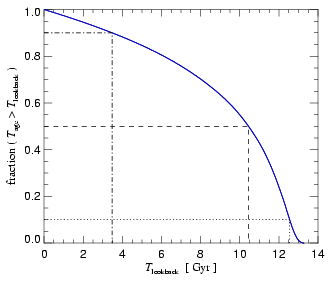
| |
|
|
This numerical study is perhaps the first that has been able to make a reliably converged prediction for the full star formation history from high redshift to the present. This has become possible by combing the computational power of modern parallel supercomputers with a sophisticated physical model for radiative cooling of gas, star formation, metal enrichment, and feedback by supernovae and galactic winds. The evolution of the cosmic star formation history is only a first step in the analysis of these simulations. It is clear that they contain much more information about the process of galaxy formation, and about the properties of the gas in galaxies and in the space between them. By comparing this rich information with observational data in detail, we hope to make further progress in the challenging task to understand cosmological galaxy formation. |
Further reading:
|
|
|||
|